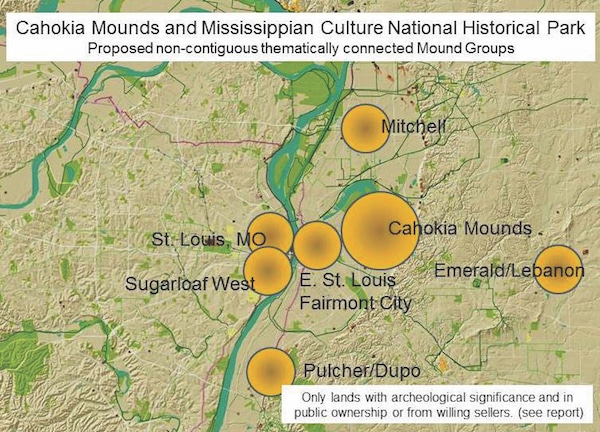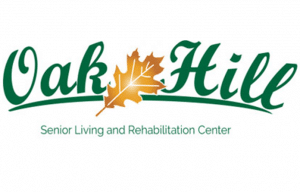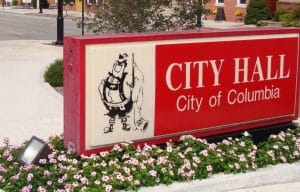National park effort for Cahokia Mounds

Efforts to make the Cahokia Mounds a national park are nearing the finish line, with legislation recently introduced in Congress by Illinois lawmakers.
Mounds in Monroe County are included in this proposal.
Rep. Mike Bost (R-Murphysboro) and Sen. Dick Durbin (D-Illinois) introduced companion bills in the House and Senate on July 18 and July 30, respectively.
“Cahokia Mounds is a significant archaeological treasure,” Bost said. “Making Cahokia Mounds and associated mounds sites in the region part of our national park system will help elevate this resource in our nation’s consciousness and deepen our understanding of the peoples and cultures of our past.”
“This designation would ensure we protect this fascinating historical site for generations to come,” Durbin echoed.
The push to get Cahokia Mounds and nearby sites national recognition has been ongoing for years, with HeartLands Conservancy, a Belleville-based organization dedicated to conservation, leading the way.
Mary Vandevord, that group’s president and CEO, praised the recent milestones.
“Elevating Cahokia Mounds and associated Mississippian mound groups to a National Historical Park would not only bring more national awareness to the Mississippian culture, but also increase tourism in southwestern Illinois and the St. Louis region,” she said.
Vandevord thanked Bost and Durbin, along with Representatives William Lacy Clay (D-St. Louis), John Shimkus (R-Collinsville) and Rodney Davis (R-Taylorville), who supported the bills.
Work to get Cahokia Mounds national recognition started gaining momentum in 2014, long before these bills were introduced. In that year, a feasibility study was completed that determined the mounds fit the criteria for a national park, in part because of its cultural significance.
While there are roughly 580 mounds in the region, HeartLands Conservancy decided it would be best to include only the most significant ones in the national park designation.
The mounds included in the proposal are located in St. Clair, Madison and Monroe counties on the Illinois side, with St. Louis also having a site on the Missouri side.
The Monroe County mounds are near the St. Clair County line south of Dupo.
Since those sites are so far apart, the national park would be non-contiguous.
“Together, they can be a national park with Cahokia being kind of the centerpiece or the epicenter,” said Ed Weilbacher of Waterloo, who vice president of HeartLands Conservancy and leader of this effort.
Although the study determining all that finished five years ago, no federal action came of it. At that time, HeartLands Conservancy moved to have the mounds named a national monument because that requires only a declaration from a president. President Barack Obama from Illinois was in office at the time.
But that did not happen.
So, it shifted focus to having the mounds named a national park, which is declared by Congress and signed by the president.
Then came another setback.
“We had to reevaluate and see what was going on,” Weilbacher recalled. “Nationally, there was some pushback against national parks in the election.”
With other nearby areas getting national park or national monument designations in recent months, the group redoubled its efforts to have the Cahokia Mounds declared the Cahokia Mounds Mississippian Culture National Historical Park.
HeartLands Conservancy arranged to have Bost introduce the bill first, with Durbin agreeing to introduce the companion bill shortly thereafter.
“These are exciting times,” Weilbacher said. “Up to this point, we were trying to reach these milestones.”
The initiative has letters of support from several Native American tribes and nations, the Illinois General Assembly, Gov. JB Pritzker, former governors, all three Illinois counties listed, municipalities including Waterloo and Red Bud, archaeological and historical groups and more.
With all that support, Weilbacher said the bills are expected to pass.
“We think it should move forward,” he said. “We’ve had tremendous support from all walks of life, with all groups thinking it should have been done a long time ago.”
If Congress passes the bills and President Donald Trump signs the final one, it would take about a year to get the national park set up.
Work done during that time would include devising a management plan with the Illinois Department National Resources – which currently administers the mounds as a state historic site – and the National Park Service combining to run the park.
A study would also be conducted to determine what programs and resources would be needed to deliver a quality experience to visitors.
Throughout that process, HeartLands Conservancy would continue to serve in an advisory role.
If all that happens and the mounds do become a national park, Weilbacher said that would provide several benefits to the region.
“What the national park designation brings to the region, it only looks at the best of the best,” he explained. “So if this wasn’t that, we couldn’t pursue it.”
“It brings an economic benefit to the region, too,” Weilbacher added. “It brings people to spend their time in hotels, restaurants and for interpretation.”






